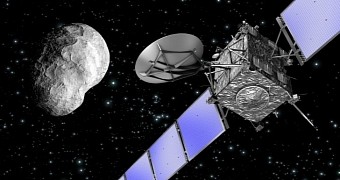Researchers with the University of Bern in Switzerland say that, having analyzed data provided by the Rosetta Orbiter Sensor for Ion and Neutral Analysis, they were able to pin down the odor of a distant comet.
The comet in question goes by the name Churyumov-Gerasimenko and is now racing through space at a distance of about 400 million kilometers (nearly 250 million miles) from the Sun.
By the looks of it, this distant celestial body smells nothing like Chanel No. 5. On the contrary, the scientists behind this research project argue that its odor is best described as downright foul.
Hence, perhaps it would have been a good idea for European Space Agency researchers to fit the Rosetta spacecraft, which is now busy orbiting the comet, with a breathing mask.
Just how bad does this comet smell?
According the University of Bern specialists behind this investigation, one of the compounds that give comet Churyumov-Gerasimenko its distinct smell is hydrogen sulphide. This particular compound lets out an odor similar to that of rotten eggs.
As if this weren't enough, it appears that the celestial body's perfume also includes the scent of ammonia, which researchers say resembles horse poo, and the scent of formaldehyde, described as pungent and suffocating.
The final notes are the almond-like aroma of hydrogen cyanide, the smell of alcohol let out by methanol, the vinegar-like aroma of sulphur dioxide, and the fairly sweet scent of carbon disulphide, Science Daily informs.
Seeing how the comet's distinct perfume is an indicator of its chemical makeup, scientists expect that this information obtained with the help of the Rosetta Orbiter Sensor for Ion and Neutral Analysis will help them gain a better understanding of the history of the universe.
“This all makes a scientifically enormously interesting mixture in order to study the origin of our solar system material, the formation of our Earth and the origin of life,” scientist Kathrin Altwegg said in a statement.
A better understanding of the comet's makeup
European Space Agency astronomers say that, come November 12, the Rosetta spacecraft will deploy a lander to the surface of comet Churyumov-Gerasimenko.
The lander, named Philae, will be in charge of documenting the comet's makeup by collecting and analyzing samples. The European Space Agency has already settled on a landing site for Philae. The name of this site, chosen following an online competition, will be announced this coming November 3.
Commenting on the importance of this research project, the scientists behind the Rosetta mission pointed out that “Comets are considered to be primitive building blocks of the Solar System and may have helped to ‘seed’ Earth with water, perhaps even the ingredients for life.”
“But many fundamental questions about these enigmatic objects remain, and through a comprehensive, in situ study of the comet, Rosetta aims to unlock the secrets within,” they added.

 14 DAY TRIAL //
14 DAY TRIAL //